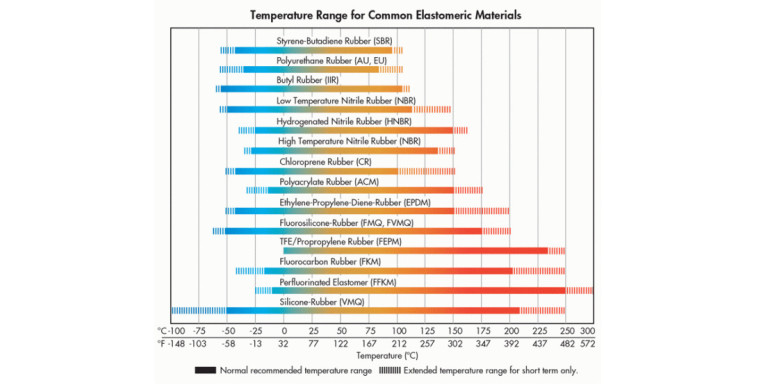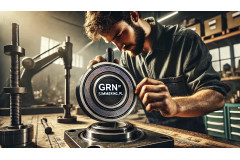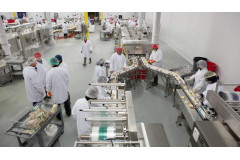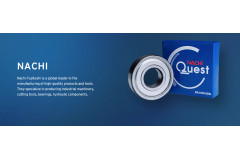
O-Ring Applications Based on Temperature – A Complete Guide
O-rings are essential sealing components used across various industries, including automotive, chemical, pharmaceutical, household appliances, and heavy industry. One of the most important factors determining the effectiveness of O-rings is the material they are made from and the temperature range in which they operate. In this article, we present different types of O-rings and their applications based on temperature.
| O-Ring Material | Temperature Range | Applications | Key Features |
|---|---|---|---|
| NBR (Nitrile-Butadiene) | -40°C to +90°C | Automotive, hydraulic seals, oil systems | Resistant to oils and lubricants, low deformation, low cost |
| HNBR | -30°C to +150°C | Air conditioning, automotive industry | Wear resistance, oil and fuel resistance, ozone and acid resistance |
| EPDM | -50°C to +150°C | Brake systems, household appliances | Resistant to steam, weather elements, non-resistant to oils |
| Viton® (FKM/FPM) | -20°C to +210°C | Chemical industry, aviation, automotive | High chemical and heat resistance, resistant to oils and UV radiation |
| Silicone (VMQ/FVMQ) | -60°C to +240°C | Food industry, pharmaceuticals, appliances | Fire-resistant, excellent electrical insulation, resistant to ozone and hot air |
| PTFE (Teflon) | -200°C to +260°C | Chemical, petrochemical, pharmaceutical | High chemical resistance, low plasticity, low friction coefficient |
| Kalrez® (FFKM) | -20°C to +327°C | Aerospace, oil rigs, semiconductors | Highest chemical and temperature resistance, reliable in extreme conditions |
How to Choose the Right O-Ring for Temperature?
Selecting the right O-ring depends on working conditions such as temperature and the medium the seal will protect. Here are some guidelines:
-
NBR O-Rings – These are the most popular choice for applications up to +90°C. Ideal for automotive, hydraulic, and oil systems, NBR O-rings are flexible and resistant to lubricants and oils but not suitable for glycol-based brake fluids.
-
HNBR O-Rings – Withstanding higher temperatures (up to +150°C), HNBR is resistant to oils, fuels, and acids with high sulfur content, making it perfect for air conditioning systems and industrial machinery.
-
EPDM O-Rings – Used in brake systems and household appliances, EPDM O-rings resist temperatures up to +150°C. They are resistant to brake fluids, steam, and detergents, commonly found in washing machines and dishwashers.
-
Viton® (FKM/FPM) O-Rings – Viton O-rings provide excellent chemical and heat resistance, making them suitable for aviation, automotive, and chemical applications. They can withstand temperatures up to +210°C and are used in fuel systems and vacuum applications.
-
Silicone (VMQ/FVMQ) O-Rings – With a temperature range up to +240°C, silicone O-rings are widely used in the food, pharmaceutical, and appliance industries. Due to their low wear resistance, they are mainly used in static applications.
-
PTFE (Teflon) O-Rings – PTFE O-rings are resistant to almost all chemicals and can work at temperatures up to +260°C. They are used in chemical, pharmaceutical, and petrochemical industries, where high chemical resistance is required.
-
Kalrez® (FFKM) O-Rings – These high-performance seals withstand temperatures up to +327°C and are used in extreme environments such as oil rigs, semiconductor production, and aerospace industries.
FAQ:
-
What O-ring is best for high-temperature applications?
The best choices are FPM (Viton®) O-rings, which can operate in temperatures up to +210°C, and FFKM (Kalrez®), which can handle up to +327°C. -
Are silicone O-rings suitable for hot water?
Yes, silicone O-rings (VMQ) are resistant to water up to +100°C, making them ideal for appliances and the food industry. -
Are NBR O-rings oil-resistant?
Yes, NBR O-rings have excellent resistance to oils, fuels, and lubricants, making them perfect for hydraulic and oil systems. -
Which O-rings are chemical-resistant?
PTFE (Teflon) and FFKM (Kalrez®) O-rings are the most chemical-resistant, making them ideal for use in chemical and pharmaceutical industries. -
Where can I buy high-temperature-resistant O-rings?
At Simmering.pl, we offer a wide selection of O-rings made from different materials that can withstand a broad range of temperatures and conditions.
Keywords:
O-Rings, NBR, FPM, HNBR, EPDM, PTFE, Viton, Elastomers, Sealing Materials, Silicone O-Rings, Industrial O-Rings, Automotive O-Rings, Seals, Simmering.pl




Leave a Reply Cancel Reply